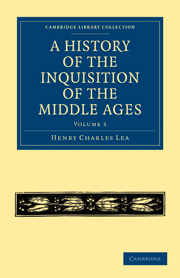Book contents
- Frontmatter
- Contents
- BOOK III SPECIAL FIELDS OF INQUISITORIAL ACTIVITY
- CHAPTER I THE SPIRITUAL FRANCISCANS
- CHAPTER II GUGLIELMA AND DOLCINO
- CHAPTER III THE FRATICELLI
- CHAPTER IV POLITICAL HERESY UTILIZED BY THE CHURCH
- CHAPTER V POLITICAL HERESY UTILIZED BY THE STATE
- CHAPTER VI SORCERY AND OCCULT ARTS
- CHAPTER VII WITCHCRAFT
- CHAPTER VIII INTELLECT AND FAITH
- CHAPTER IX CONCLUSION
- APPENDIX OF DOCUMENTS
- INDEX
CHAPTER II - GUGLIELMA AND DOLCINO
Published online by Cambridge University Press: 29 August 2010
- Frontmatter
- Contents
- BOOK III SPECIAL FIELDS OF INQUISITORIAL ACTIVITY
- CHAPTER I THE SPIRITUAL FRANCISCANS
- CHAPTER II GUGLIELMA AND DOLCINO
- CHAPTER III THE FRATICELLI
- CHAPTER IV POLITICAL HERESY UTILIZED BY THE CHURCH
- CHAPTER V POLITICAL HERESY UTILIZED BY THE STATE
- CHAPTER VI SORCERY AND OCCULT ARTS
- CHAPTER VII WITCHCRAFT
- CHAPTER VIII INTELLECT AND FAITH
- CHAPTER IX CONCLUSION
- APPENDIX OF DOCUMENTS
- INDEX
Summary
The spiritual exaltation which produced among the Franciscans the developments described in the last chapter was by no means confined to the recognized members of that Order. It manifested itself in even more irregular fashion in the little group of sectaries known as Guglielmites, and in the more formidable demonstration of the Dolcinists, or Apostolic Brethren.
About the year 1260 there came to Milan a woman calling herself Guglielma. That she brought with her a son shows that she had lived in the world, and was doubtless tried with its vicissitudes, and as the child makes no further appearance in her history, he probably died young. She had wealth, and was said to be the daughter of Constance, queen and wife of the King of Bohemia. Her royal extraction is questionable, but the matter is scarce worth the discussion which it has provoked. She was a woman of preeminent piety, who devoted herself to good works, without practising special austerities, and she gradually attracted around her a little band of disciples, to whom such of her utterances as have been recorded show that she gave wholesome ethical instruction. They adopted the style of plain brown garment which she habitually wore, and seem to have formed a kind of unorganized congregation, bound together only by common devotion to her.
- Type
- Chapter
- Information
- A History of the Inquisition of the Middle Ages , pp. 90 - 128Publisher: Cambridge University PressPrint publication year: 2010First published in: 1888

